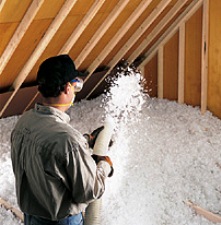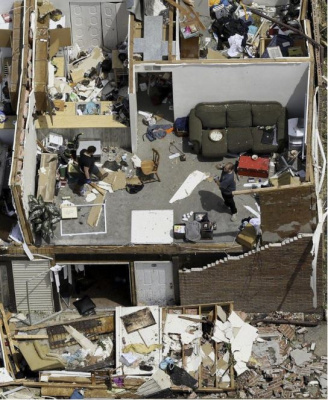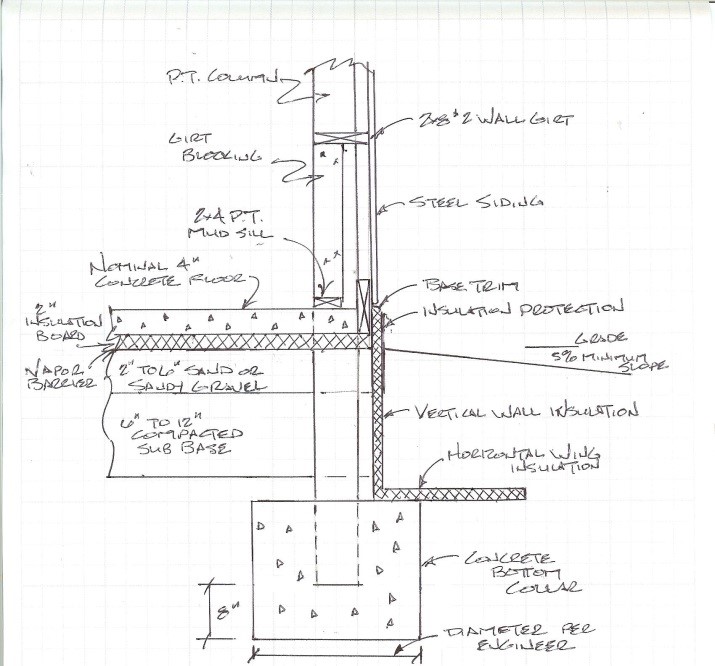I’ve personally used and experienced wonderful results with a product referred to by the trade name BIBS®. You can read more about it on the internet: www.bibs.com
I know I’m going to sound like a commercial talking about how great this stuff is, but I honestly have no affiliation with the company producing it. I just happen to have used BIBS® insulation in my most recently constructed building, and I love it.
What is it? Simply, a shredded fiberglass material mixed with a light adhesive. A fine netting is placed over the inside of the framing and insulation is blown into place.
 Besides offering an “R” value of over 4 per inch, I was impressed when standing inside my building with the wind blowing 60 miles an hour outside. Inside…it was completely quiet. If I hadn’t been fighting the raging wind outside earlier in the day, I’d have never known the wind was blowing so hard.
Besides offering an “R” value of over 4 per inch, I was impressed when standing inside my building with the wind blowing 60 miles an hour outside. Inside…it was completely quiet. If I hadn’t been fighting the raging wind outside earlier in the day, I’d have never known the wind was blowing so hard.
And because BIBS® is blown in, there are no gaps. It eliminates voids, thus reducing heat loss. Due to its density and the way it’s blown in under pressure to fill every space, there is no settling. I can attest to this as I have some yet unfinished areas in the 3rd story area of my building, and over seven years later, there are still no gaps or evidence of settling!
When my wife and I considered insulation for our big storage building (60×84), with a loft for our new “living space” we checked out all types of insulation. BIBS® insulation was less expensive than foam, and had some advantages due to the design of our new building. Five years later, we‘d do it all over again. We are often surprised to wake up mornings finding it has rained and realize we didn’t even hear it, even with a steel roof.
BIBS® was blown into some very irregular spaces in our pole building. It has a gambrel roof style and custom designed windows, which have odd angles and spaces around them. I know we’d never have filled those voids with any other type of insulation and had such a complete and tight “fit” with any other insulation. Having the insulation tight around plumbing reduces the possibility of freezing pipes in the wintertime. We have no drafty outlets…no drafty anything, due to BIBS®.
Probably the only “down” side to this product for you do-it-yourselfers is it is only installed by certified BIBS® installers. However, to their credit they come in knowing exactly what they are doing, so having experienced installers cuts down on labor costs overall. I know this is one “do-it-yourself” project I am happy to pass along (this and concrete!) to those “in the know”. There are just some things you want and need to have done “right” and this is one of them. After seven years, I am a happy camper with the results of choosing BIBS® for part of our insulation needs. We have a phenomenally low heating and A/C bill, amazing sound control (quiet!), and maybe just the feeling of being “snug as a bug in a rug” …which is pretty nice considering winter is…coming!










My pole barn is 24×32. I have no wrap on walls, just metal against horizontal girts. How do I insulate without condensation. I have seen videos of foam board being placed in between girts then framing wall with craft faced or roxul before osb or plywood. Just not sure if I should have air space and put foam board or bubble wrap vertically over girts or get the 1.5″ foam board and run horizontally in between girts.
Completely fill your insulation cavity with Roxul, use a well sealed vapor barrier on inside of framing. You may need to dehumidify your building, especially if you have no under slab vapor barrier.
Do we need 2 inches of closed cell on the metal roof before adding BIBS or other insulation? Won’t closed cell seal off the roof vent? Insulation guy told us that they don’t spray closed cell behind the posts. Won’t this cause heat loss? Insulation is trickier than we thought it would be. We’re in zone 6A and have in floor thermal storage heat.
In Climate Zone 6A I would use a Weather Resistant Barrier between wall steel and framing, then either R-20 BIBs or unfaced batts, with R-5 well-sealed rigid insulation on interior (or R-13 plus R-10 rigid). For roof, Integral Condensation Control factory applied to underside of roof steel, vented eaves and ridge, and blow in R-60 using raised heel trusses. I would not use closed cell spray foam in most instances.
We were not given the choice of factory applied condensation control, so that ship has sailed. We have vented eaves and ridge as well as raised heel trusses. We will be looking for a bid from a BIBs contractor. Our understanding is that closed cell on roof is our best option. Our peak is 30+feet with 16 feet to the bottom of the attic trusses.